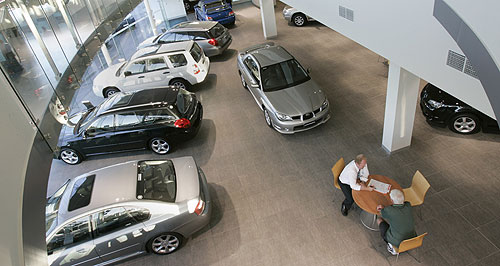Make / Model Search
News - General News - SalesCar dealer profits increaseNo deal: New car dealers may be too dependent on finance and insurance sales to boost profit margins. Finance, insurance key factors behind dealer profitability, not car sales: Deloitte29 Apr 2013 By IAN PORTER AUSTRALIAN new car dealers had their most profitable year in 2012 since at least 1996 as buyers rushed into showrooms and drove away a record 1.11 million new vehicles. But manufacturer incentives, mainly discounts and finance offers, meant that the profits were built on foundations of sand. On average, dealers reported a return on sales exceeding 2 per cent for the year, a massive 40 per cent higher than the average of 1.4 per cent for the previous six years, according to leading corporate audit and advice group Deloitte. However, the 2013 Deloitte Motor Industry Report shows that it was not the surge in new vehicle sales that drove earnings upwards but the attendant increase in sales of finance and insurance. “It was not at all uncommon for a dealer in 2012 to find that the profits from F&I (finance and insurance) represented over 100 per cent of the total profit in their dealership,” said Deloitte Motor Industry Services lead partner Danny Rezek. “This raises a concern that some dealers are coming to rely too heavily on this source of income.” If the F&I earnings represent 100 per cent of the dealer’s profits, this means that the other parts of the dealership – new cars, used cars, parts and service – were only breaking even or even losing money. In fact, Mr Rezek suggested that some dealers might have been selling new vehicles at a loss just so they could write F&I business. “Such is the dominance of F&I at the moment, that it almost seems that some dealers have adopted a strategy of selling vehicles simply to generate the opportunity to sell finance and insurance products,” he said. “Such a dependency (on F&I) carries risks, especially in an environment where credit could become constrained.” This could be sparked by events overseas, he said, like a European economy spiralling out of control and causing a sudden shock to world credit markets. “Should there be some interruption to this stream of F&I revenue – such as a tightening in global credit markets – then there has to be a question about how well dealers would recover from this.” The heavy reliance on F&I income is a result of the intense competition for new vehicle sales in the Australian market, Mr Rezek said. The market has been flooded, in two senses. First, the addition of Opel and Infiniti raised the number of passenger car brands to 47, a level not seen in any other market. Second, the strong Australian dollar has made imported cars around 33 per cent more competitive price-wise over recent years. This does not show in reduced selling prices as much as it does it extremely high levels of equipment at the same selling price as in past years. “With the currency continuing to favour imported vehicles, there has been a flood of new models entering the market,” Mr Rezek said. “Most brands these days have multiple vehicles competing in each of the passenger, SUV and light commercial segments, whereas 20 years ago very few brands were in the SUV market at all.” The battle for new car sales, driven by manufacturer incentives, appears to have worked against dealers, cruelling their new car profits. “It seemed that the fierce competition which was driving the volume boom also drove down gross profit margins to the point that, despite the high volumes, for the average dealer the pool of new car gross profit they were seeing actually shrunk,” Mr Rezek said. Quite apart from the number of brands competing for sales, the overall market volume was inflated by manufacturers trying to unload as much production as possible from their northern hemisphere factories. “With many western markets, particularly Europe, continuing to be depressed, the steady and reliable Australian market has been perceived by global manufacturers as one with the capacity to soak up excess stock,” said Mr Rezek, without accusing the manufacturers of dumping in Australia. “Many manufacturers have, therefore, pursued a “supply push” strategy for Australia driven by the need to ensure their manufacturing plants continue to operate and vital cash continues to flow. “This has been evident for a few years but appears to have intensified in 2012. Generous incentives from manufacturers to encourage dealers to achieve sales targets have, in many eyes, created an abnormal market which some believe is above the natural level of demand. “Although some claim such practices simply create a timing difference, in that they simply pull forward demand, others argue that they can have lasting effects by putting pressure on vehicle residuals, thereby impacting used vehicle operations, and they can also frustrate selling cultures in dealerships.”  Read more |
Click to shareGeneral News articlesResearch General News Motor industry news |












Facebook Twitter Instagram